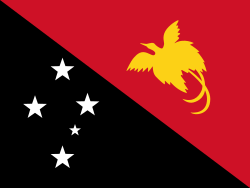Papua New Guinea
country in Oceania From Wikipedia, the free encyclopedia
Remove ads
Papua New Guinea is an island country located on the Pacific Ocean. It is the east half of New Guinea island, plus some nearby islands. The capital city of Papua New Guinea is Port Moresby. The population of Papua New Guinea are mostly the Indigenous peoples of the island.
Remove ads
The island is in both Australasia and Oceania, which are two different terms for the continent of islands in the Pacific area. It borders Indonesia to the west and near Australia to the south.
Papua New Guinea has more languages than any other country.[6]
Remove ads
History
Long ago, around 42,000 to 45,000 years ago, people came to Papua New Guinea. They were related to people who left Africa a long time ago and moved to other parts of the world. A study in 2016 found that it was about 50,000 years ago that these people came to a big land called Sahul, which is Australia and New Guinea combined. About 10,000 years ago, the sea level rose and New Guinea became an island. But even before that, the people in Australia and Papua New Guinea became different from each other about 37,000 years ago. Scientists found out that the ancestors of Papuans mixed with another group of people called Denisovans when they were in Asia a long time ago. They share 4% to 7% of their genes with these ancient people.
Around 9,000 years ago, people in New Guinea started growing their own plants and farming. This was one of the few places in the world where people did this without learning it from others. Later, around 2,500 years ago, some people who spoke Austronesian languages moved to the coasts of New Guinea. They brought new things like pottery, pigs, and fishing methods with them.
In the 18th century, traders brought a new kind of food called sweet potato to New Guinea. It was from South America and introduced by Portuguese traders to the Moluccas. People in New Guinea liked it and it became a popular food. Sweet potato gardens produced more crops than the traditional taro, and this helped societies grow and become more prosperous.
Remove ads
Divisions
Administrative divisions
Papua New Guinea is divided into four regions. These regions are important for government, commercial, sporting and other activities.
The nation has 20 province-level divisions: eighteen, the Autonomous Region of Bougainville and the National Capital District. Each province is divided into one or more districts. The districts are divided into one or more Local Level Government areas.
The province-level divisions are as follows:
|
|
 |
Parliament has approved two additional provinces by 2012: Hela Province, which will be part of the current Southern Highlands Province, and Jiwaka Province, which will be formed by dividing Western Highlands Province.[7]
In Morobe (#11 on the map) there is a goldfield.
Remove ads
References
Other websites
Wikiwand - on
Seamless Wikipedia browsing. On steroids.
Remove ads



